Line Manager's Role in Travel Agency: HR Practices and Performance
VerifiedAdded on 2022/09/02
|7
|1543
|16
Report
AI Summary
This report examines the crucial role of line managers within a travel agency, particularly focusing on their functions in operational management and human resource practices. It explores how line managers, acting as a bridge between organizational goals and employee performance, are essential for addressing the fluctuating demands of the tourism industry. The report outlines the key responsibilities of line managers, including staff training, quality control, and performance target setting. Furthermore, it analyzes the HR practices specific to a travel agency, such as employee screening, interview techniques for temporary staff, and performance evaluation methods. The report also highlights the challenges in standardizing employee performance due to the intangible nature of the tourism product and emphasizes the importance of adaptability and teamwork in this sector. References from academic journals and books are included to support the analysis.
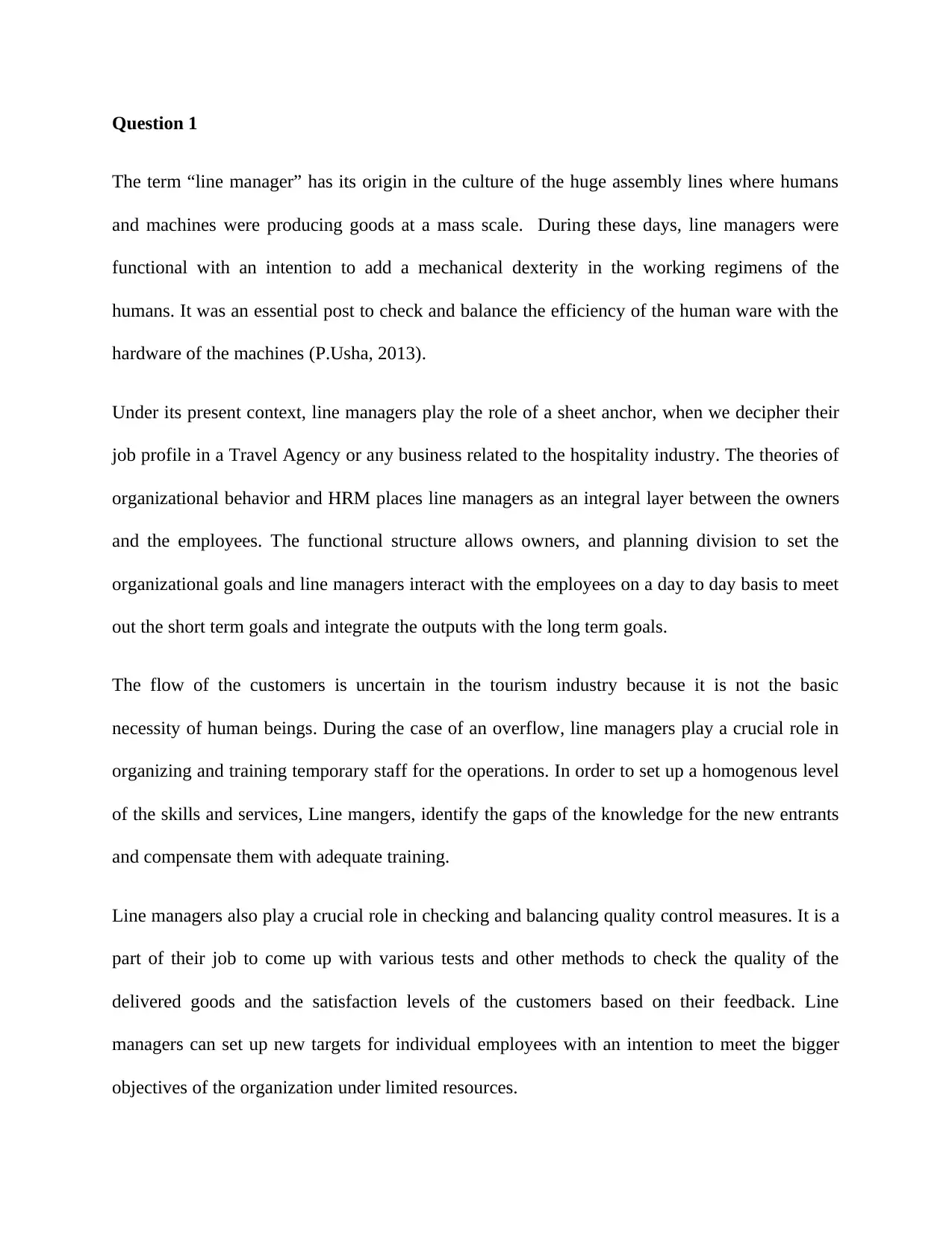
Question 1
The term “line manager” has its origin in the culture of the huge assembly lines where humans
and machines were producing goods at a mass scale. During these days, line managers were
functional with an intention to add a mechanical dexterity in the working regimens of the
humans. It was an essential post to check and balance the efficiency of the human ware with the
hardware of the machines (P.Usha, 2013).
Under its present context, line managers play the role of a sheet anchor, when we decipher their
job profile in a Travel Agency or any business related to the hospitality industry. The theories of
organizational behavior and HRM places line managers as an integral layer between the owners
and the employees. The functional structure allows owners, and planning division to set the
organizational goals and line managers interact with the employees on a day to day basis to meet
out the short term goals and integrate the outputs with the long term goals.
The flow of the customers is uncertain in the tourism industry because it is not the basic
necessity of human beings. During the case of an overflow, line managers play a crucial role in
organizing and training temporary staff for the operations. In order to set up a homogenous level
of the skills and services, Line mangers, identify the gaps of the knowledge for the new entrants
and compensate them with adequate training.
Line managers also play a crucial role in checking and balancing quality control measures. It is a
part of their job to come up with various tests and other methods to check the quality of the
delivered goods and the satisfaction levels of the customers based on their feedback. Line
managers can set up new targets for individual employees with an intention to meet the bigger
objectives of the organization under limited resources.
The term “line manager” has its origin in the culture of the huge assembly lines where humans
and machines were producing goods at a mass scale. During these days, line managers were
functional with an intention to add a mechanical dexterity in the working regimens of the
humans. It was an essential post to check and balance the efficiency of the human ware with the
hardware of the machines (P.Usha, 2013).
Under its present context, line managers play the role of a sheet anchor, when we decipher their
job profile in a Travel Agency or any business related to the hospitality industry. The theories of
organizational behavior and HRM places line managers as an integral layer between the owners
and the employees. The functional structure allows owners, and planning division to set the
organizational goals and line managers interact with the employees on a day to day basis to meet
out the short term goals and integrate the outputs with the long term goals.
The flow of the customers is uncertain in the tourism industry because it is not the basic
necessity of human beings. During the case of an overflow, line managers play a crucial role in
organizing and training temporary staff for the operations. In order to set up a homogenous level
of the skills and services, Line mangers, identify the gaps of the knowledge for the new entrants
and compensate them with adequate training.
Line managers also play a crucial role in checking and balancing quality control measures. It is a
part of their job to come up with various tests and other methods to check the quality of the
delivered goods and the satisfaction levels of the customers based on their feedback. Line
managers can set up new targets for individual employees with an intention to meet the bigger
objectives of the organization under limited resources.
Paraphrase This Document
Need a fresh take? Get an instant paraphrase of this document with our AI Paraphraser
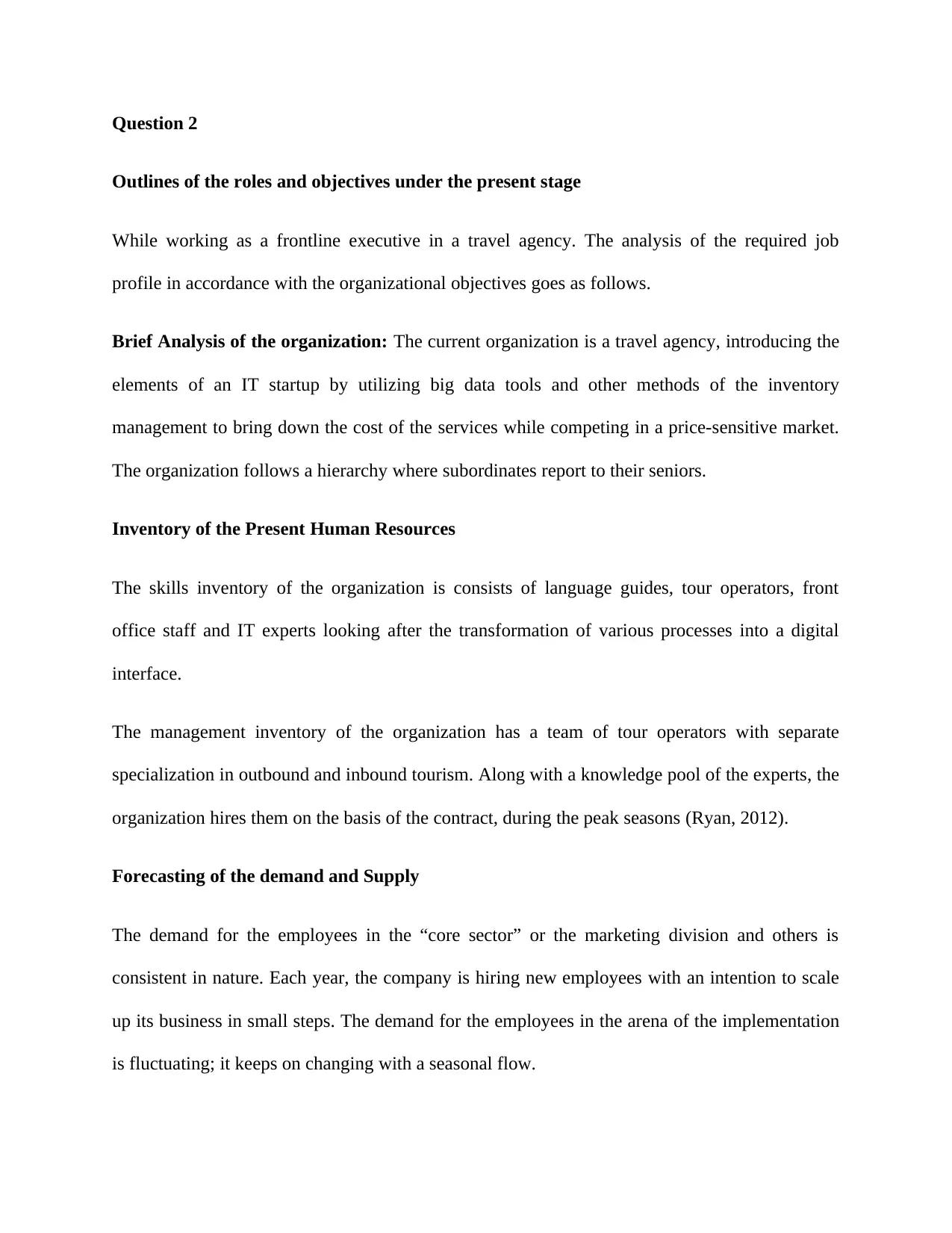
Question 2
Outlines of the roles and objectives under the present stage
While working as a frontline executive in a travel agency. The analysis of the required job
profile in accordance with the organizational objectives goes as follows.
Brief Analysis of the organization: The current organization is a travel agency, introducing the
elements of an IT startup by utilizing big data tools and other methods of the inventory
management to bring down the cost of the services while competing in a price-sensitive market.
The organization follows a hierarchy where subordinates report to their seniors.
Inventory of the Present Human Resources
The skills inventory of the organization is consists of language guides, tour operators, front
office staff and IT experts looking after the transformation of various processes into a digital
interface.
The management inventory of the organization has a team of tour operators with separate
specialization in outbound and inbound tourism. Along with a knowledge pool of the experts, the
organization hires them on the basis of the contract, during the peak seasons (Ryan, 2012).
Forecasting of the demand and Supply
The demand for the employees in the “core sector” or the marketing division and others is
consistent in nature. Each year, the company is hiring new employees with an intention to scale
up its business in small steps. The demand for the employees in the arena of the implementation
is fluctuating; it keeps on changing with a seasonal flow.
Outlines of the roles and objectives under the present stage
While working as a frontline executive in a travel agency. The analysis of the required job
profile in accordance with the organizational objectives goes as follows.
Brief Analysis of the organization: The current organization is a travel agency, introducing the
elements of an IT startup by utilizing big data tools and other methods of the inventory
management to bring down the cost of the services while competing in a price-sensitive market.
The organization follows a hierarchy where subordinates report to their seniors.
Inventory of the Present Human Resources
The skills inventory of the organization is consists of language guides, tour operators, front
office staff and IT experts looking after the transformation of various processes into a digital
interface.
The management inventory of the organization has a team of tour operators with separate
specialization in outbound and inbound tourism. Along with a knowledge pool of the experts, the
organization hires them on the basis of the contract, during the peak seasons (Ryan, 2012).
Forecasting of the demand and Supply
The demand for the employees in the “core sector” or the marketing division and others is
consistent in nature. Each year, the company is hiring new employees with an intention to scale
up its business in small steps. The demand for the employees in the arena of the implementation
is fluctuating; it keeps on changing with a seasonal flow.

Estimation of the gap in the manpower
With the arrival of IT-related tools, the agency is currently passing through a phase of transition
where they are focusing on the training of the core employees with the intention of IT
enablement. This is a phase of transition where the culture of temporary hiring is finding a way
and concerns related to cost-cutting are creating a problem in the consistent supply of the
workers.
Formulation of the final action plan
In order to meet the future requirements of the manpower supply, the organization should come
up with pools of employees. For instance, they can generate a knowledge pool and conserve the
tacit knowledge of the organization. Apart from it, a core group of employees can handpick
employees to carry out operations from a temporary employee pool.
Monitoring, control, and feedback
Line managers can conduct direct surveys with the customers and check their satisfaction levels.
Apart from it, internal audits can be performed to check the efficiency and work done by various
employees. This exercise can help the line the managers in setting up justified targets for the
employees and keep a check on the quality-related norms.
Question 3
Under the present circumstances, the screening for suitable temporary employees can be
considered as a permanent exercise for the agency because of a lack of supply of talented
individuals. As far as the core team is concerned, Line managers can adopt the technique of
With the arrival of IT-related tools, the agency is currently passing through a phase of transition
where they are focusing on the training of the core employees with the intention of IT
enablement. This is a phase of transition where the culture of temporary hiring is finding a way
and concerns related to cost-cutting are creating a problem in the consistent supply of the
workers.
Formulation of the final action plan
In order to meet the future requirements of the manpower supply, the organization should come
up with pools of employees. For instance, they can generate a knowledge pool and conserve the
tacit knowledge of the organization. Apart from it, a core group of employees can handpick
employees to carry out operations from a temporary employee pool.
Monitoring, control, and feedback
Line managers can conduct direct surveys with the customers and check their satisfaction levels.
Apart from it, internal audits can be performed to check the efficiency and work done by various
employees. This exercise can help the line the managers in setting up justified targets for the
employees and keep a check on the quality-related norms.
Question 3
Under the present circumstances, the screening for suitable temporary employees can be
considered as a permanent exercise for the agency because of a lack of supply of talented
individuals. As far as the core team is concerned, Line managers can adopt the technique of
⊘ This is a preview!⊘
Do you want full access?
Subscribe today to unlock all pages.

Trusted by 1+ million students worldwide
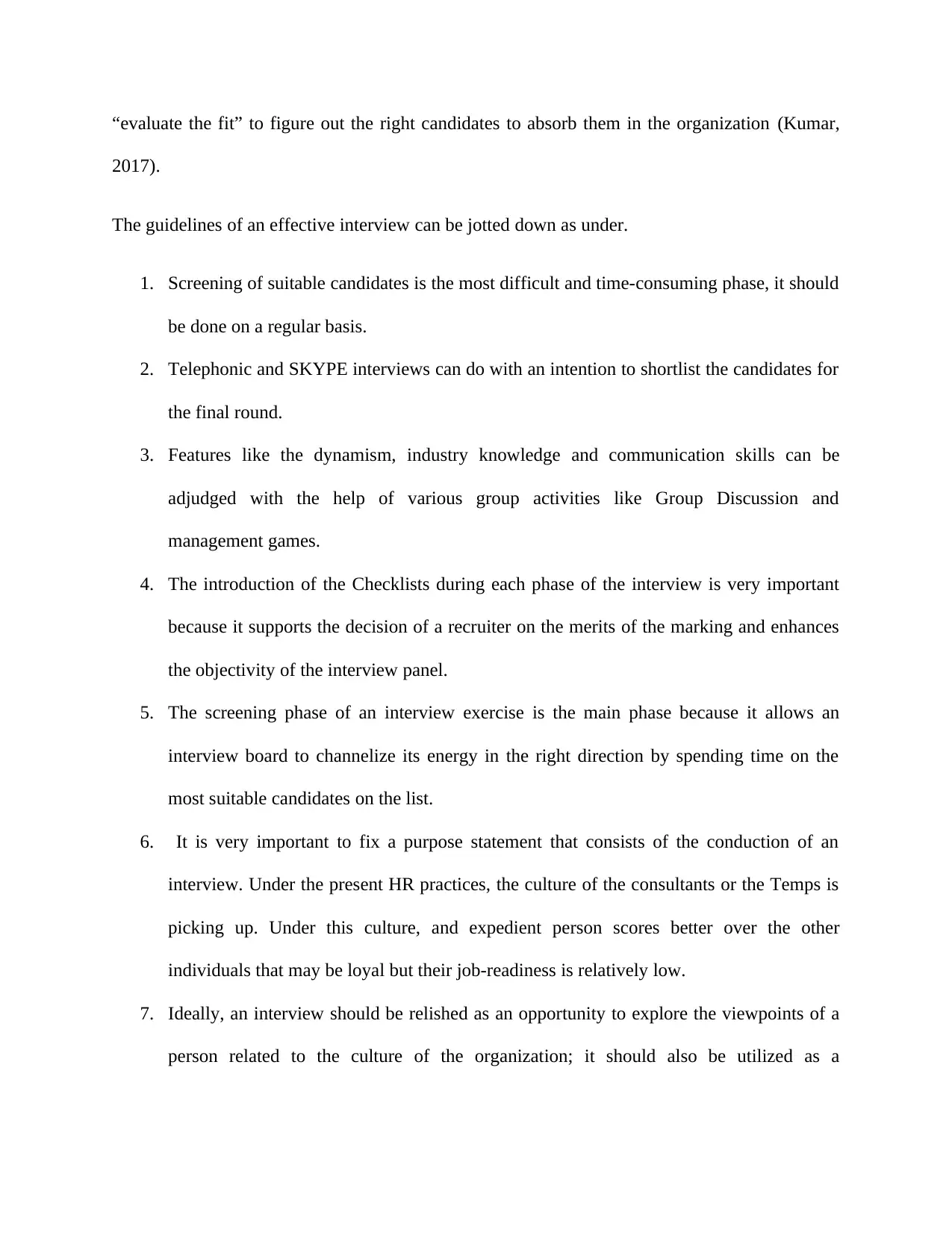
“evaluate the fit” to figure out the right candidates to absorb them in the organization (Kumar,
2017).
The guidelines of an effective interview can be jotted down as under.
1. Screening of suitable candidates is the most difficult and time-consuming phase, it should
be done on a regular basis.
2. Telephonic and SKYPE interviews can do with an intention to shortlist the candidates for
the final round.
3. Features like the dynamism, industry knowledge and communication skills can be
adjudged with the help of various group activities like Group Discussion and
management games.
4. The introduction of the Checklists during each phase of the interview is very important
because it supports the decision of a recruiter on the merits of the marking and enhances
the objectivity of the interview panel.
5. The screening phase of an interview exercise is the main phase because it allows an
interview board to channelize its energy in the right direction by spending time on the
most suitable candidates on the list.
6. It is very important to fix a purpose statement that consists of the conduction of an
interview. Under the present HR practices, the culture of the consultants or the Temps is
picking up. Under this culture, and expedient person scores better over the other
individuals that may be loyal but their job-readiness is relatively low.
7. Ideally, an interview should be relished as an opportunity to explore the viewpoints of a
person related to the culture of the organization; it should also be utilized as a
2017).
The guidelines of an effective interview can be jotted down as under.
1. Screening of suitable candidates is the most difficult and time-consuming phase, it should
be done on a regular basis.
2. Telephonic and SKYPE interviews can do with an intention to shortlist the candidates for
the final round.
3. Features like the dynamism, industry knowledge and communication skills can be
adjudged with the help of various group activities like Group Discussion and
management games.
4. The introduction of the Checklists during each phase of the interview is very important
because it supports the decision of a recruiter on the merits of the marking and enhances
the objectivity of the interview panel.
5. The screening phase of an interview exercise is the main phase because it allows an
interview board to channelize its energy in the right direction by spending time on the
most suitable candidates on the list.
6. It is very important to fix a purpose statement that consists of the conduction of an
interview. Under the present HR practices, the culture of the consultants or the Temps is
picking up. Under this culture, and expedient person scores better over the other
individuals that may be loyal but their job-readiness is relatively low.
7. Ideally, an interview should be relished as an opportunity to explore the viewpoints of a
person related to the culture of the organization; it should also be utilized as a
Paraphrase This Document
Need a fresh take? Get an instant paraphrase of this document with our AI Paraphraser
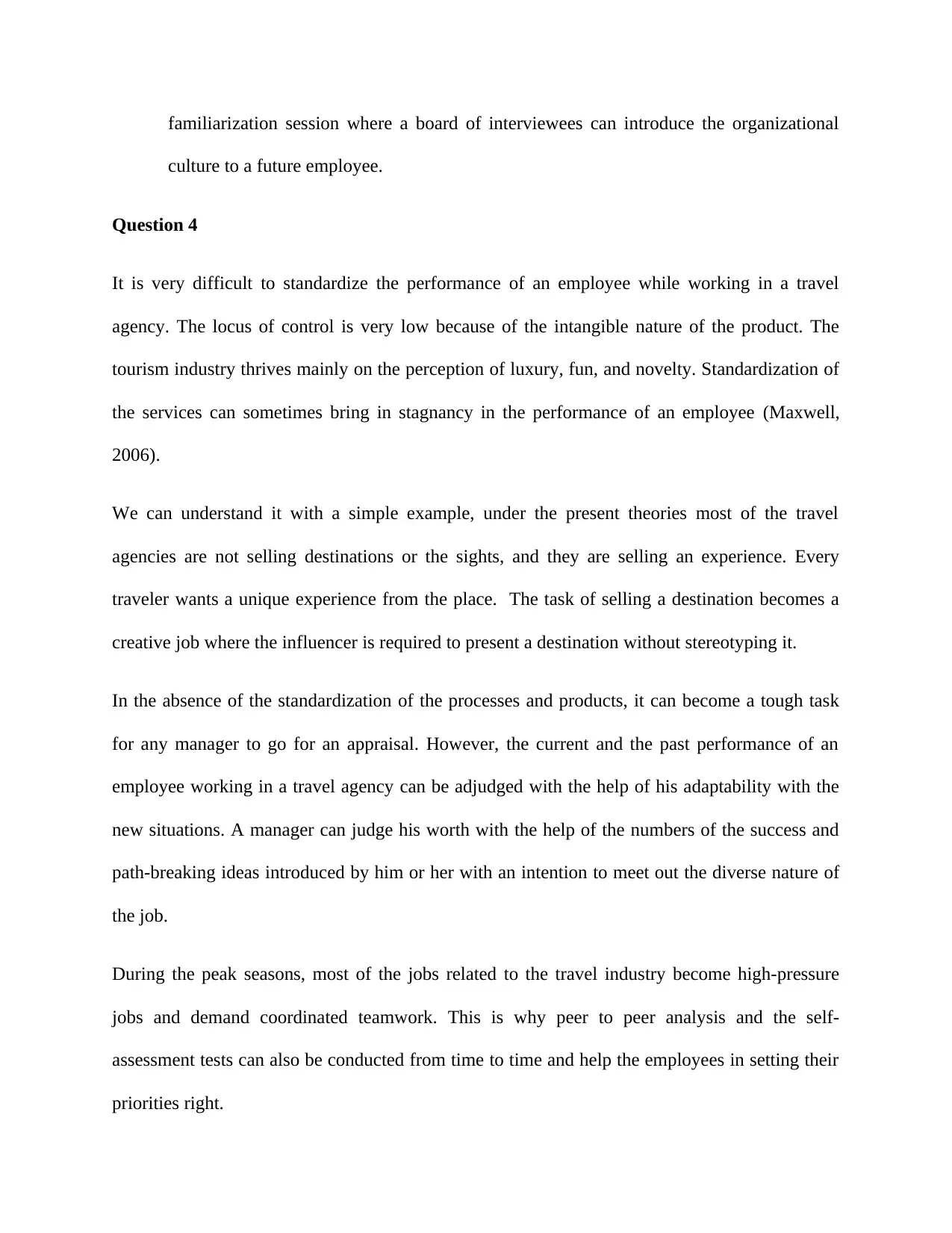
familiarization session where a board of interviewees can introduce the organizational
culture to a future employee.
Question 4
It is very difficult to standardize the performance of an employee while working in a travel
agency. The locus of control is very low because of the intangible nature of the product. The
tourism industry thrives mainly on the perception of luxury, fun, and novelty. Standardization of
the services can sometimes bring in stagnancy in the performance of an employee (Maxwell,
2006).
We can understand it with a simple example, under the present theories most of the travel
agencies are not selling destinations or the sights, and they are selling an experience. Every
traveler wants a unique experience from the place. The task of selling a destination becomes a
creative job where the influencer is required to present a destination without stereotyping it.
In the absence of the standardization of the processes and products, it can become a tough task
for any manager to go for an appraisal. However, the current and the past performance of an
employee working in a travel agency can be adjudged with the help of his adaptability with the
new situations. A manager can judge his worth with the help of the numbers of the success and
path-breaking ideas introduced by him or her with an intention to meet out the diverse nature of
the job.
During the peak seasons, most of the jobs related to the travel industry become high-pressure
jobs and demand coordinated teamwork. This is why peer to peer analysis and the self-
assessment tests can also be conducted from time to time and help the employees in setting their
priorities right.
culture to a future employee.
Question 4
It is very difficult to standardize the performance of an employee while working in a travel
agency. The locus of control is very low because of the intangible nature of the product. The
tourism industry thrives mainly on the perception of luxury, fun, and novelty. Standardization of
the services can sometimes bring in stagnancy in the performance of an employee (Maxwell,
2006).
We can understand it with a simple example, under the present theories most of the travel
agencies are not selling destinations or the sights, and they are selling an experience. Every
traveler wants a unique experience from the place. The task of selling a destination becomes a
creative job where the influencer is required to present a destination without stereotyping it.
In the absence of the standardization of the processes and products, it can become a tough task
for any manager to go for an appraisal. However, the current and the past performance of an
employee working in a travel agency can be adjudged with the help of his adaptability with the
new situations. A manager can judge his worth with the help of the numbers of the success and
path-breaking ideas introduced by him or her with an intention to meet out the diverse nature of
the job.
During the peak seasons, most of the jobs related to the travel industry become high-pressure
jobs and demand coordinated teamwork. This is why peer to peer analysis and the self-
assessment tests can also be conducted from time to time and help the employees in setting their
priorities right.

⊘ This is a preview!⊘
Do you want full access?
Subscribe today to unlock all pages.

Trusted by 1+ million students worldwide
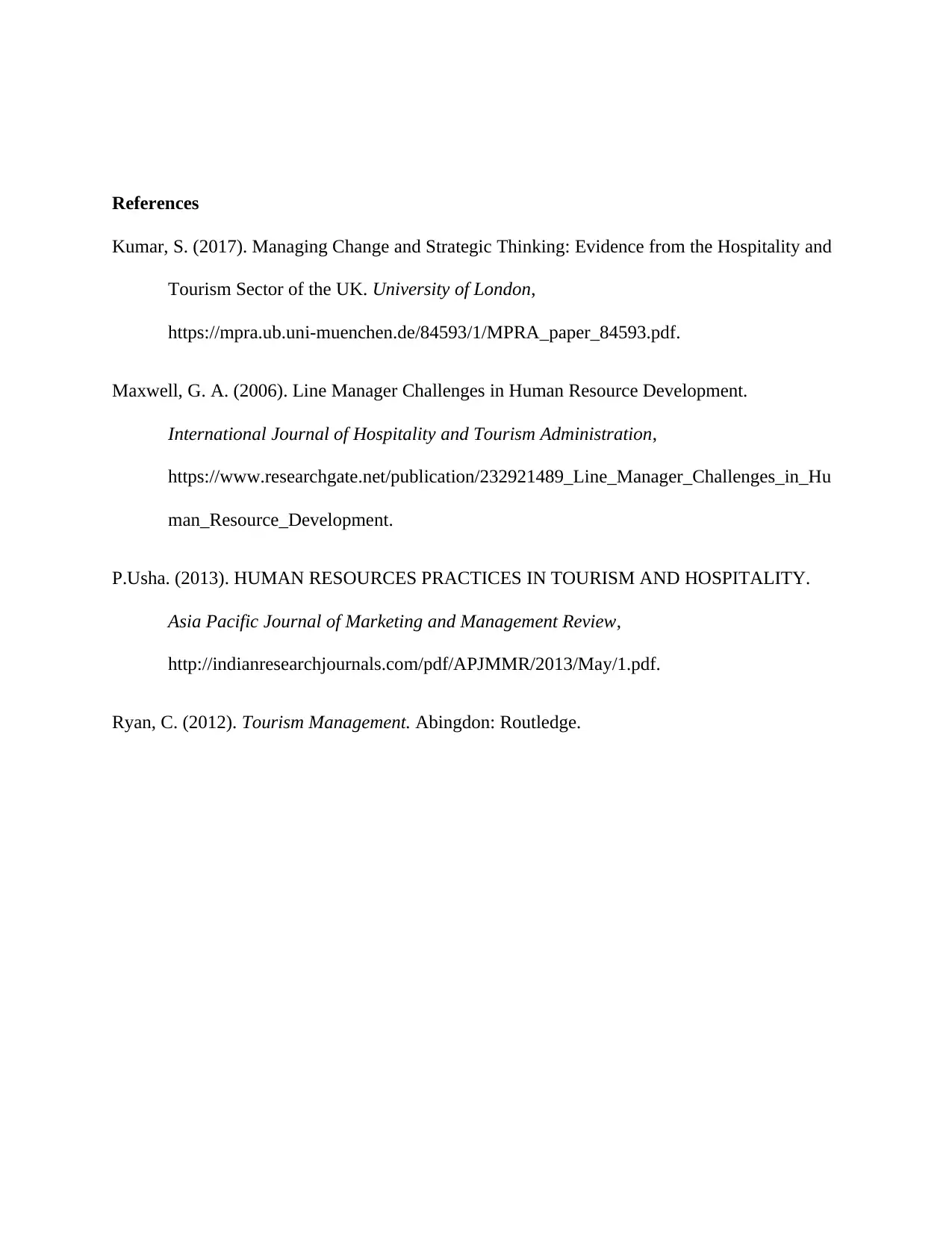
References
Kumar, S. (2017). Managing Change and Strategic Thinking: Evidence from the Hospitality and
Tourism Sector of the UK. University of London,
https://mpra.ub.uni-muenchen.de/84593/1/MPRA_paper_84593.pdf.
Maxwell, G. A. (2006). Line Manager Challenges in Human Resource Development.
International Journal of Hospitality and Tourism Administration,
https://www.researchgate.net/publication/232921489_Line_Manager_Challenges_in_Hu
man_Resource_Development.
P.Usha. (2013). HUMAN RESOURCES PRACTICES IN TOURISM AND HOSPITALITY.
Asia Pacific Journal of Marketing and Management Review,
http://indianresearchjournals.com/pdf/APJMMR/2013/May/1.pdf.
Ryan, C. (2012). Tourism Management. Abingdon: Routledge.
Kumar, S. (2017). Managing Change and Strategic Thinking: Evidence from the Hospitality and
Tourism Sector of the UK. University of London,
https://mpra.ub.uni-muenchen.de/84593/1/MPRA_paper_84593.pdf.
Maxwell, G. A. (2006). Line Manager Challenges in Human Resource Development.
International Journal of Hospitality and Tourism Administration,
https://www.researchgate.net/publication/232921489_Line_Manager_Challenges_in_Hu
man_Resource_Development.
P.Usha. (2013). HUMAN RESOURCES PRACTICES IN TOURISM AND HOSPITALITY.
Asia Pacific Journal of Marketing and Management Review,
http://indianresearchjournals.com/pdf/APJMMR/2013/May/1.pdf.
Ryan, C. (2012). Tourism Management. Abingdon: Routledge.
1 out of 7
Related Documents
Your All-in-One AI-Powered Toolkit for Academic Success.
+13062052269
info@desklib.com
Available 24*7 on WhatsApp / Email
![[object Object]](/_next/static/media/star-bottom.7253800d.svg)
Unlock your academic potential
Copyright © 2020–2025 A2Z Services. All Rights Reserved. Developed and managed by ZUCOL.





